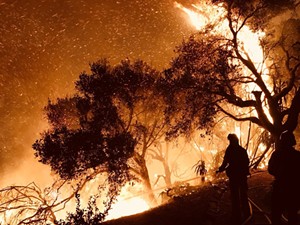Utility provider Pacific Gas and Electric (PG&E) Company announced that it could shut off power in huge swaths of California for days at a time in an attempt to prevent future wildfires like the burns the company was blamed for in 2017 and 2018, and local businesses and health care providers are trying to prepare for the potential blackouts.

“It’s really important for us to let our community know that this is something we’re preparing for,” said Jackie Ruiz, a spokesperson for the Santa Barbara County Public Health Department.
Ruiz said it’s difficult to tell exactly how a days-long power outage would impact local hospitals and clinics, which rely on electricity to power medical equipment—including oxygen pumps and dialysis machines—that are vital to keeping patients alive. All hospitals in Santa Barbara County have generators and backup fuel stored, but Ruiz said it’s unclear how long that fuel would last during an extensive power shutdown.
The Public Health Department is working to help health care organizations plan for outages and the potentially unforeseen impacts as best they can through the Public Health Emergency Preparedness Program, an initiative the county launched in an effort to better prepare for disasters like the Thomas Fire and Montecito mudslides.
Through the program, a “disaster health care coalition” helps health providers across the county prepare for specific kinds of disasters, which Ruiz said include sudden power outages. Part of that preparation involves an annual drill during which local hospitals work through a three-day extended power-outage scenario.
About 66 health care facilities participated in the most recent drill, which Ruiz said was held in November 2018. In a debriefing after last year’s event, Ruiz said health care industry employees who participated said the experience helped them plan for power outage situations they hadn’t previously considered.
“So I think it was eye opening in that respect,” Ruiz told the Sun.
The “public safety power shutoffs” are part of PG&E’s 2019 Wildfire Safety Plan, which outlines ways PG&E plans to prevent future wildfires like those it caused in past years, including the Camp Fire, a burn that destroyed the town of Paradise and killed 85 people.
In addition to inspecting its existing electric infrastructure, building more resilient infrastructure, and enhancing its vegetation management work, PG&E plans to shut down power in areas where especially hot, dry, and windy weather conditions pose the threat of wildfire.
The energy company says it will consider reports by the National Weather Service, humidity levels, wind forecasts, and on-the-ground observations from PG&E field crews to determine when and where the outages are necessary. Because extreme weather can last several hours or days, PG&E suggests customers prepare for outages that could last longer than 48 hours.
Customers in high fire-threat areas are more likely to be affected by the outages, but the company says that because the energy system relies on power lines working together across regions, a blackout could impact any of the more than 5 million customers who receive electric service from PG&E.
Claire Wineman, president of the Grower-Shipper Association of Santa Barbara and San Luis Obispo Counties, said that unexpected situations like these are why legislators should be wary of restricting a variety of power sources.
“We didn’t anticipate this being an issue a handful of years ago,” Wineman told the Sun, adding that the power outages could be even more difficult for farmers to navigate in the future if things like diesel-fueled generators are completely banned.
During extensive outages, Wineman said farmers and ranchers will have to find new ways to power their cooling and cold storage facilities, where produce and meat have to be kept immediately after harvesting or butchering. Electric irrigation pumps would also be shut down during a power outage.
In the summer months, Wineman said most farmers could likely turn to solar power during an electric blackout. But during the winter, there often isn’t enough sunshine to power entire farms. In those situations, Wineman said it’s important for farmers and ranchers to have diverse back-up power options to choose from.
Most local organizations are still learning about PG&E’s power outages and the impacts they could have. PG&E plans to share information about its Community Wildfire Safety Program and the shutdowns with customers in Santa Barbara and San Luis Obispo counties at an open house Thursday, June 20. The event will run from 6 to 8 p.m. at 333 Madonna Road in San Luis Obispo.









